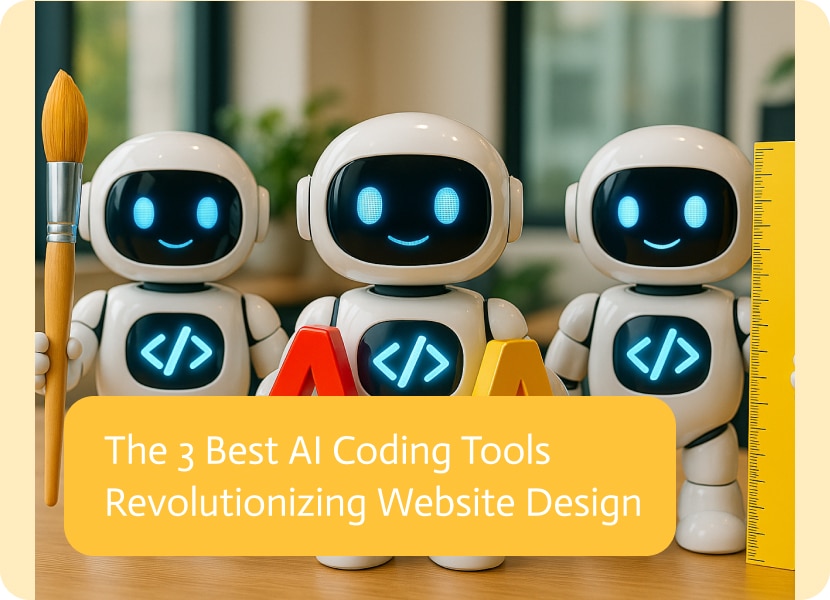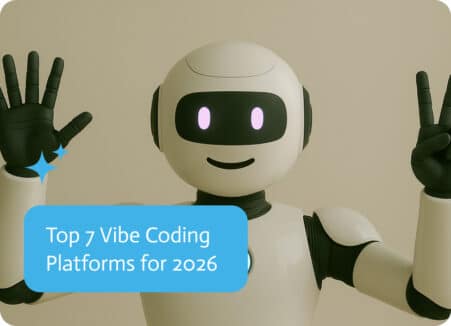

The 3 Best AI Coding Tools Revolutionizing Website Design
The web changes faster than most of us can keep up, and with every new exciting step forward, the bar for good design is set higher. In the not so distant past, building a striking site meant untold hours of time spent coding, and maybe a team of experts, not to mention a healthy budget. These days though, it’s cutting that time in half and skipping most of the headaches, because a smart tool does the heavy lifting for you.
That’s exactly what the newest AI coding helpers are doing. Designers no longer need to wrestle with table layouts or memorize every CSS trick; they can simply type, give me a clean blog homepage with a hero image and three sections, and watch the code manifest in a matter of moments. By giving the AI the ability to deal with routine jobs, from mock-up to live launch, these programs free up creative minds to focus on big ideas rather than all that mundane work.
Soon, AI will do more than follow directions, it will come up with ideas you never considered. By watching how people behave, scanning for shifts within a certain industry, and reading the voice of your brand, the technology will start suggesting buttons, copy tweaks, accessibility fixes, and SEO changes on its own. Designers can step into a director role, experimenting with their creativity, and all of this while AI lifts the routine, code-heavy work. The payoff is faster pages, smoother journeys for users, and lets not forget about all the design flexibility that barely existed a few years back.
Noca.ai: The Vibe-Coding Visionary
So, just imagine you describe your dream website in everyday words, and it appears on the screen. That is Noca’s bold promise, and the startup calls its approach vibe coding. Under this banner, plain-language vision mixes with smart tech, turning casual speech into powerful, ready-to-launch apps and sleek sites. It goes beyond the usual no-code pitch; it opens a door of pure curiosity, letting anyone share an idea without touching traditional code.
Noca shines because it really gets the subtleties of what users want. Thanks to its NLP interface, you can just explain the screen you picture and the steps you need, and Noca will then turn that description into a polished UI and a smooth series of processes regarding the back-end. Apart from that, the AI agents platform also completes all the linking, plugging into ERPs, CRMs, payment gateways, and more, so you can skip the usual hours that are wasted messing around with the whole setup.
Noca isn’t a one-and-done tool; it keeps learning as you do. Its adaptive AI watches your changes and fine-tunes code, all while throwing in useful suggestions on the spot, so you see better ideas almost immediately. It goes a step further by somewhat guiding you toward the best layouts, parts, and speed fixes the moment you add a new feature. For companies, those design perks come with auto-scaling servers, strong security locks, and clear, auditable code that’s been designed to meet standards like SOC 2. Because of that, non-technical team members can now build anything they can dream of. Whether it be a simple CRM to a full supply chain dashboard, all by saying exactly what they need.
Wix: The AI-Powered Builder
Wix has been the go-to tool for weekend hobbyists and small-business owners who need a quick website, but the brand has recently added so much artificial intelligence that it feels less like a template editor and more like a super smart personal assistant. This shift takes the platform well past the old drag-and-drop style, giving users pop-up suggestions, automatic layouts.
At the center of Wix’s AI tools sits the new AI Site Builder, a friendly chatbot that spins up a full website which is based on all the answers you gave it. It doesn’t just sketch the colors and fonts, it lays out menus, pages, and the general vibe, giving you a solid frame to start from. Once the bones are in place, the AI Text Creator jumps in, writing catchy headlines or paragraphs in whatever tone you pick, so your brand voice stays steady from page to page. Pictures get the same care: the AI Image Creator can make fresh graphics, polish a blurry upload, remove those unwanted backgrounds, but it can even bump resolution so images look sharp on every screen.
Wix also looks after sight lines by serving up smart SEO tips that tell you which meta tags, structured snippets, and redirects could help search engines find you faster. Even with all this heavy lifting from AI, Wix makes sure users still steer the ride. The classic drag-and-drop editor is right there, letting you slide, swap, or delete anything until it’s almost exactly what you wanted. This mix of high-tech help and hands-on tweaking suits everyone from a coffee shop opening its first online store to an artist showing off a portfolio, since hosting, domains, and marketing tools are bundled neatly in one plan.
Relume: Your AI Design Partner for Organized Development
Currently, the vast majority of website builders bundle all the stuff together from start to finish. Relume, however, takes a more focused route by acting as a clever AI partner throughout the design and build phases. It does not try to replace creative minds; instead, it sharpens their speed and accuracy, giving teams who use Webflow and Figma a clear, step-by-step framework to work from.
Relume shines in those hectic first stages of any web project. Its sitemap generator can turn a couple of simple sentences about your company, or idea into a full page list almost instantly, laying a clear and thorough groundwork. That outline then feeds into wireframe mode, where the AI swaps raw links for clean screens populated with real elements, speeding up approvals and letting designers move forward without endless back-and-forth.
Beyond its solid layout options, Relume quickly spins up a style guide so every page looks and feels the same, right from launch. With over a thousand ready-made components sitting in the library, teams can drag them straight into Figma, Webflow, or React and skip the repetitive setup step. That heavy stack of premade pieces turns Relume into a go-to sidekick for agencies, freelancers, and dev squads, letting them mock up ideas fast, win client approval, and keep the design tone steady. The upshot? Work gets done quicker, and the whole project stays organized.
Choosing Your AI: A Brief Consideration
The options are very impressive when it comes to what’s available these days, each with their own flair. Before diving in, ask yourself how much lifting you really want the tool to do. Do you need it to shape the whole site, or just polish tricky bits of your current flow? Think, too, about the style freedom you crave, whether your task is a quick landing page, a full e-commerce engine, or a feature-packed app. And don’t forget how well the new kit sits on top of the tools you already use and whether your crew has any coding know-how. From no-code magic to coder-friendly boosts, the road ahead is bright.
The Future is Now: Empowering Web Creation
When artificial intelligence takes on website design, it does more than speed things up, it opens the door for anyone to build online. Programs like Noca, Wix, and Relume each have tricks of their own, letting testers and smaller companies turn ideas into live pages faster than ever. You can even integrate a text to speech agent to make websites more accessible and interactive, giving visitors a richer experience.
Looking ahead, as AIs continue their incredible evolution, we’re bound to get even friendlier, stronger tools that keep websites fresh, daring, and wide open for all.


